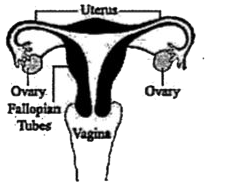Describe the human female reproductive system with the help of labelled diagram.
Step-by-Step Solution:
1. Introduction to the Human Female Reproductive System:
The human female reproductive system is a complex structure responsible for the production of female gametes (ova), the site of fertilization, and the development of the fetus during pregnancy. It includes several key components.
2. Key Components:
- Ovaries: These are the primary female sex organs, present in pairs, and are responsible for producing ova (eggs) and hormones like estrogen and progesterone.
- Oviducts (Fallopian Tubes): These tubes transport the ova from the ovaries to the uterus. They have three parts: the infundibulum (the funnel-shaped opening), the ampulla (the wider middle region), and the isthmus (the narrow region near the uterus).
- Uterus: This is a hollow, muscular organ where the fertilized egg implants and develops into a fetus. It has three layers: the endometrium (inner lining), myometrium (muscular middle layer), and perimetrium (outer layer).
- Cervix: The lower part of the uterus that opens into the vagina. It contains the cervical canal, which allows the passage of menstrual fluid and sperm.
- Vagina: A muscular tube that connects the cervix to the external genitalia and serves as the birth canal during delivery.
- External Genitalia: This includes structures such as the labia majora, labia minora, clitoris, and vaginal opening.
- Mammary Glands: These glands are responsible for producing milk to nourish the infant after birth.
3. Labelled Diagram:
- Draw a diagram of the female reproductive system, including the following labels:
- Ovaries
- Oviducts (Fallopian Tubes)
- Uterus
- Cervix
- Vagina
- External Genitalia
- Mammary Glands
4. Function of Each Component:
- Ovaries: Produce ova and hormones.
- Oviducts: Transport ova; site of fertilization.
- Uterus: Nurtures the developing fetus.
- Cervix: Allows passage between uterus and vagina.
- Vagina: Serves as a passage for menstrual fluid, sperm, and childbirth.
- External Genitalia: Protects internal structures and plays a role in sexual intercourse.
- Mammary Glands: Produce milk for breastfeeding.
5. Conclusion:
The human female reproductive system is essential for reproduction, encompassing various organs that work together to facilitate the processes of ovulation, fertilization, pregnancy, and childbirth.
The human female reproductive system is a complex structure responsible for the production of female gametes (ova), the site of fertilization, and the development of the fetus during pregnancy. It includes several key components.
- Ovaries: These are the primary female sex organs, present in pairs, and are responsible for producing ova (eggs) and hormones like estrogen and progesterone.
- Oviducts (Fallopian Tubes): These tubes transport the ova from the ovaries to the uterus. They have three parts: the infundibulum (the funnel-shaped opening), the ampulla (the wider middle region), and the isthmus (the narrow region near the uterus).
- Uterus: This is a hollow, muscular organ where the fertilized egg implants and develops into a fetus. It has three layers: the endometrium (inner lining), myometrium (muscular middle layer), and perimetrium (outer layer).
- Cervix: The lower part of the uterus that opens into the vagina. It contains the cervical canal, which allows the passage of menstrual fluid and sperm.
- Vagina: A muscular tube that connects the cervix to the external genitalia and serves as the birth canal during delivery.
- External Genitalia: This includes structures such as the labia majora, labia minora, clitoris, and vaginal opening.
- Mammary Glands: These glands are responsible for producing milk to nourish the infant after birth.
- Draw a diagram of the female reproductive system, including the following labels:
- Ovaries
- Oviducts (Fallopian Tubes)
- Uterus
- Cervix
- Vagina
- External Genitalia
- Mammary Glands
- Ovaries: Produce ova and hormones.
- Oviducts: Transport ova; site of fertilization.
- Uterus: Nurtures the developing fetus.
- Cervix: Allows passage between uterus and vagina.
- Vagina: Serves as a passage for menstrual fluid, sperm, and childbirth.
- External Genitalia: Protects internal structures and plays a role in sexual intercourse.
- Mammary Glands: Produce milk for breastfeeding.
The human female reproductive system is essential for reproduction, encompassing various organs that work together to facilitate the processes of ovulation, fertilization, pregnancy, and childbirth.
Topper's Solved these Questions
- HUMAN REPRODUCTIONBOOK - MODERN PUBLICATIONCHAPTER - HUMAN REPRODUCTIONEXERCISE - REVISION EXERCISES (LONG ANSWER TYPE QUESTION (B) QUESTION FROM CBSE EXAMINATION)
25 Videos
- HUMAN REPRODUCTIONBOOK - MODERN PUBLICATIONCHAPTER - HUMAN REPRODUCTIONEXERCISE - COMPETITION FILE (OBJECTIVE TYPE QUESTIONS (A) MULTIPLE CHOICE QUESTIONS)
183 Videos
- HUMAN REPRODUCTIONBOOK - MODERN PUBLICATIONCHAPTER - HUMAN REPRODUCTIONEXERCISE - REVISION EXERCISES (SHORT ANSWER TYPE QUESTION (B )QUESTIONS FROM CBSE EXAMINATIONS)
19 Videos
- HUMAN HEALTH AND DISEASESBOOK - MODERN PUBLICATIONCHAPTER - HUMAN HEALTH AND DISEASESEXERCISE - Chapter Practice Test
2 Videos
- MICROBES IN HUMAN WELFAREBOOK - MODERN PUBLICATIONCHAPTER - MICROBES IN HUMAN WELFAREEXERCISE - CHAPTER PRACTICE TEST (Long Answer Type Question )(Five marks each)(Section -E)
8 Videos
Similar Questions
Knowledge Check
The reproductive system is correctly labelled in which diagram?
A B
B C
C D
D
Describe the structure of human female reproductive system with a neat labelled diagram
View SolutionDescribe the male reproductive organs in humans with the help of a labelled diagram.
View SolutionGive a brief account of human male reproductive system with well labelled diagrams.
View SolutionWrite a note on human male and female reproductive system with neat labelled diagram
View SolutionDescribe the three parts of male reproductive system in human
View SolutionDescribe reproductive system of female cockroach with the help of a labelled diagram.
View SolutionDescribe various types of epithelial tissues with the help of labelled diagrams.
View Solution
